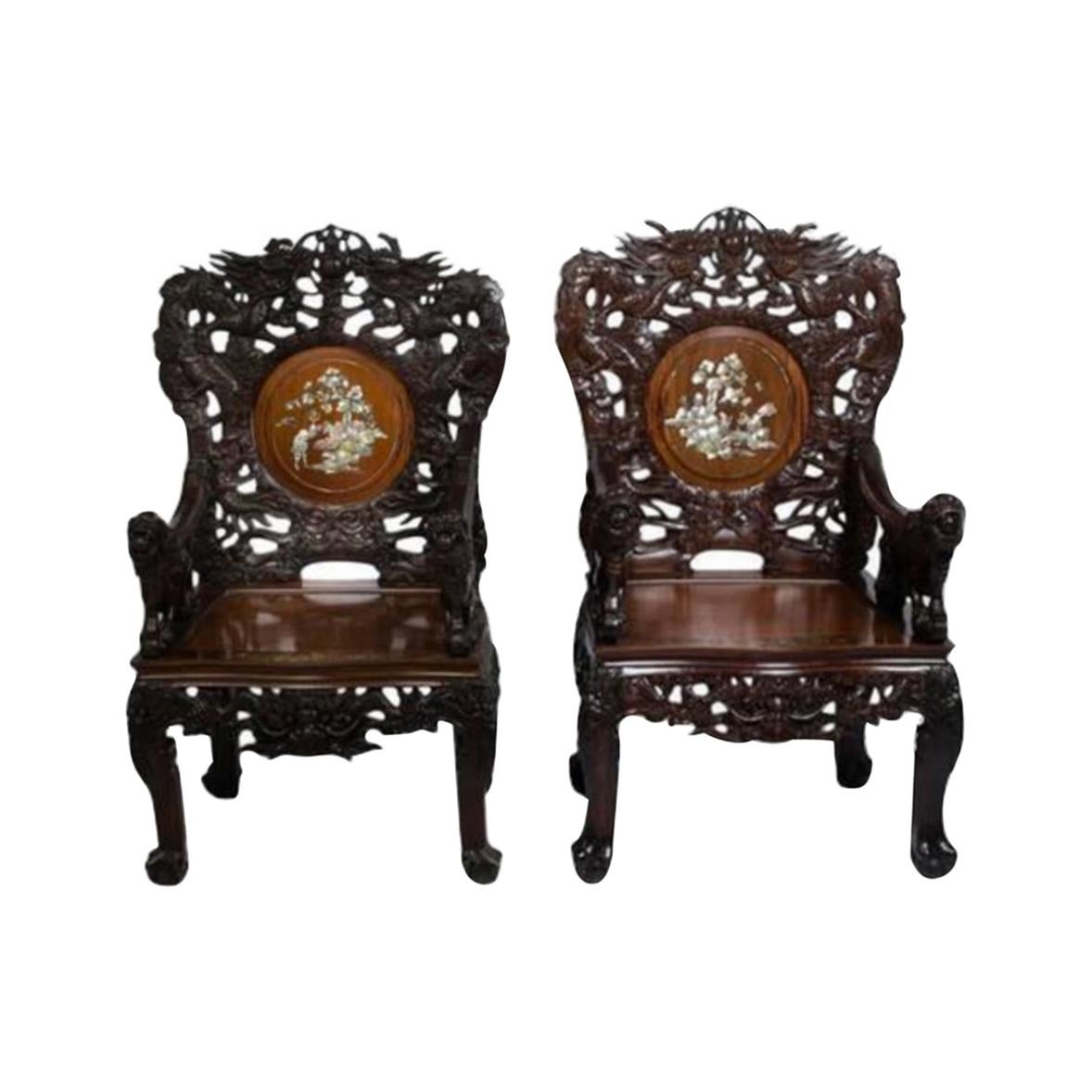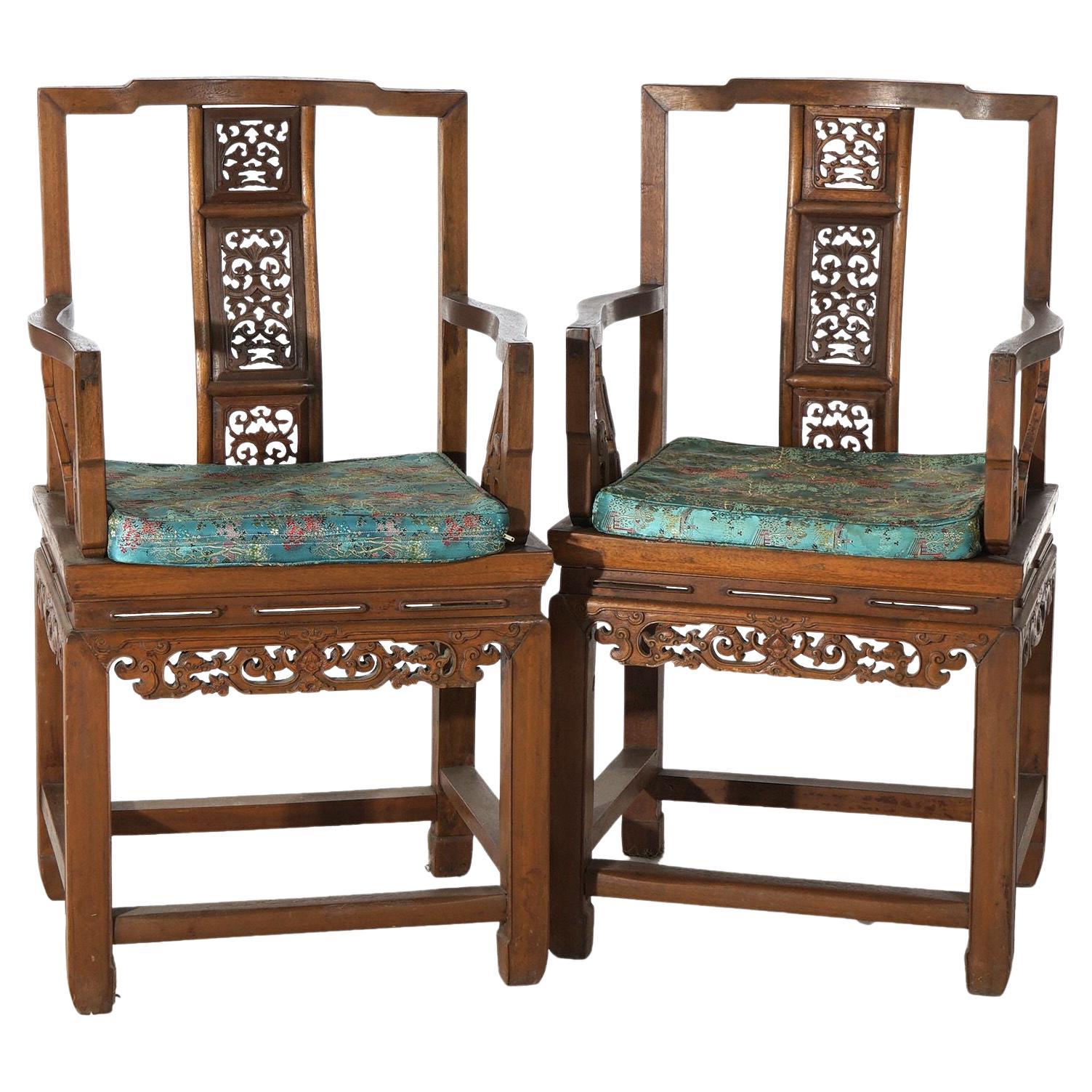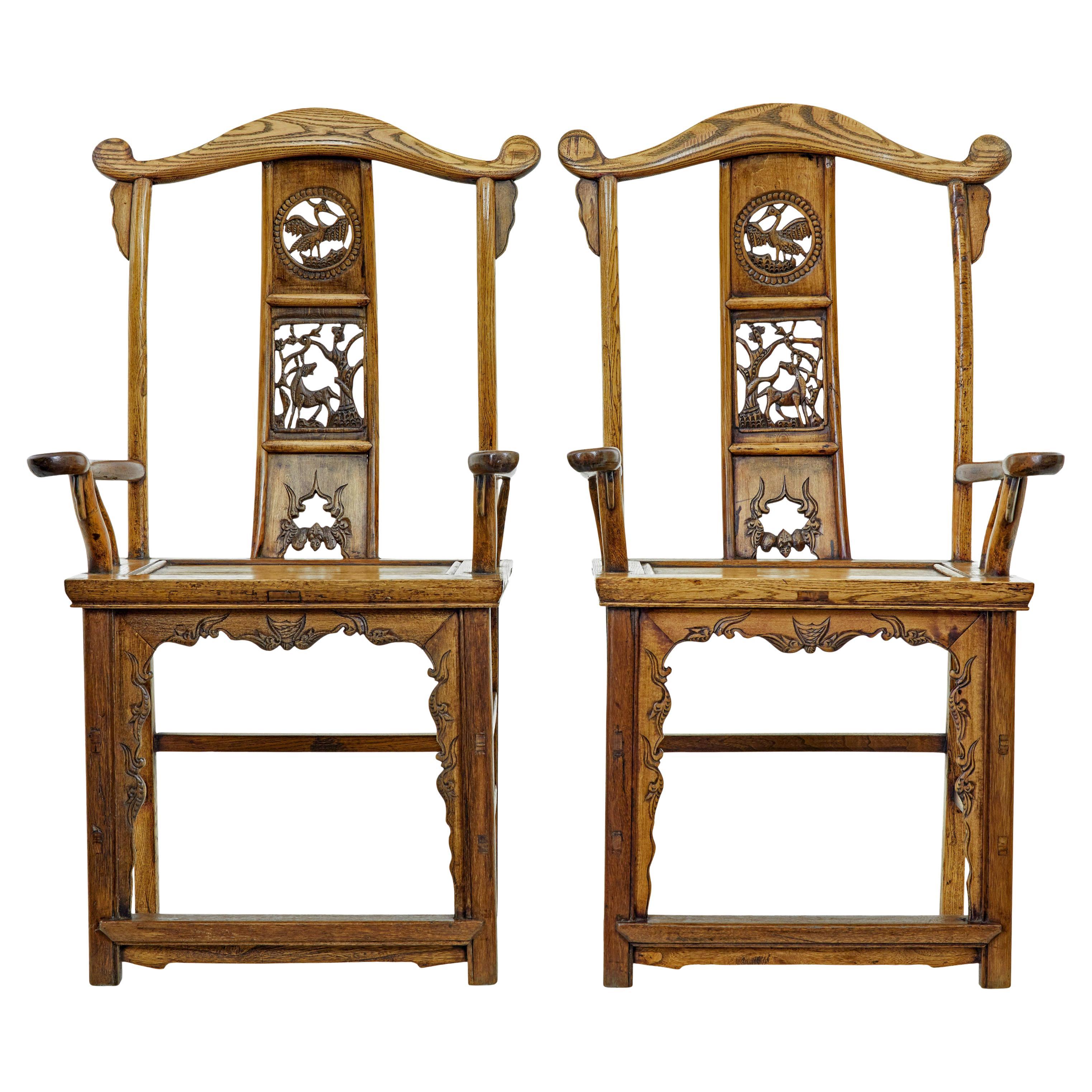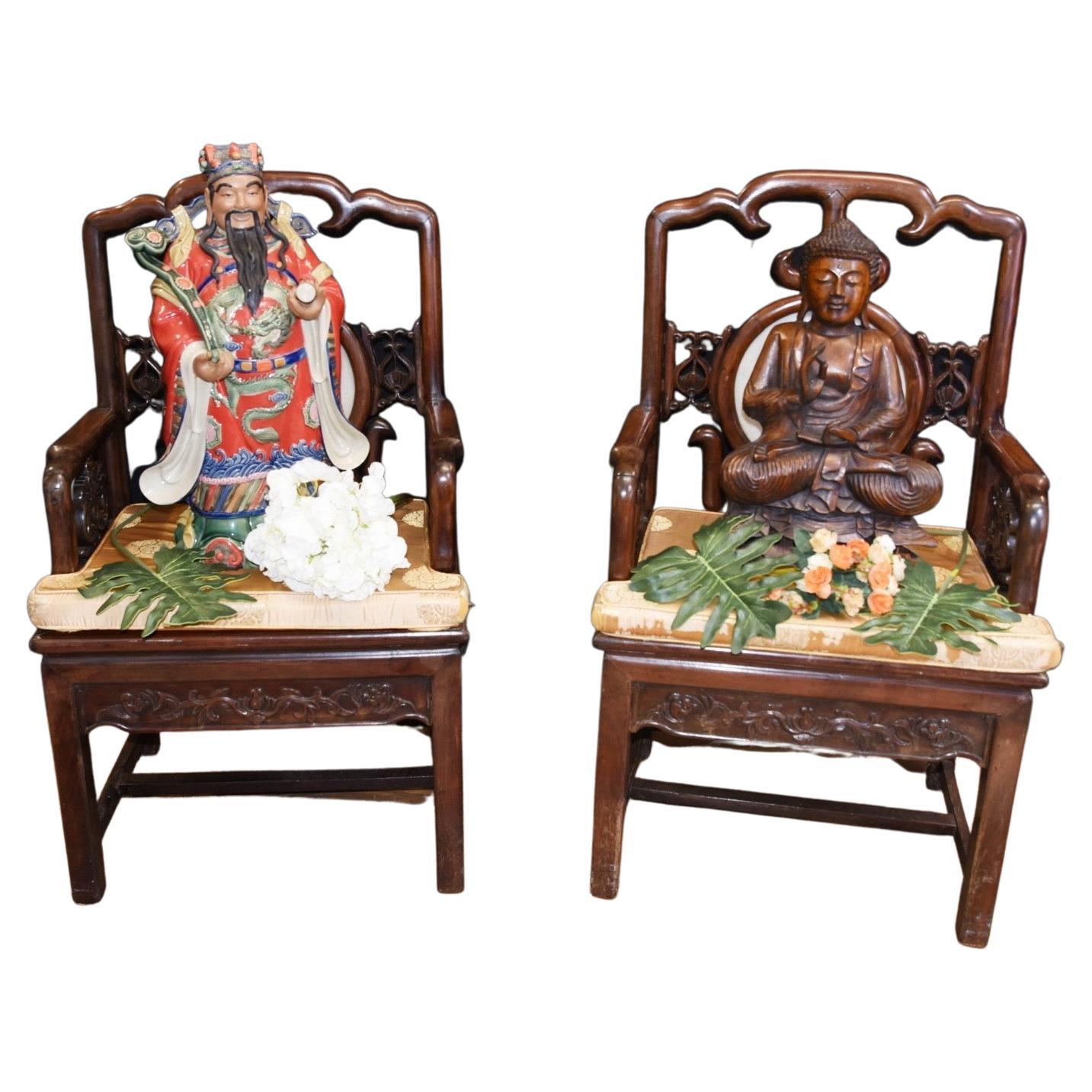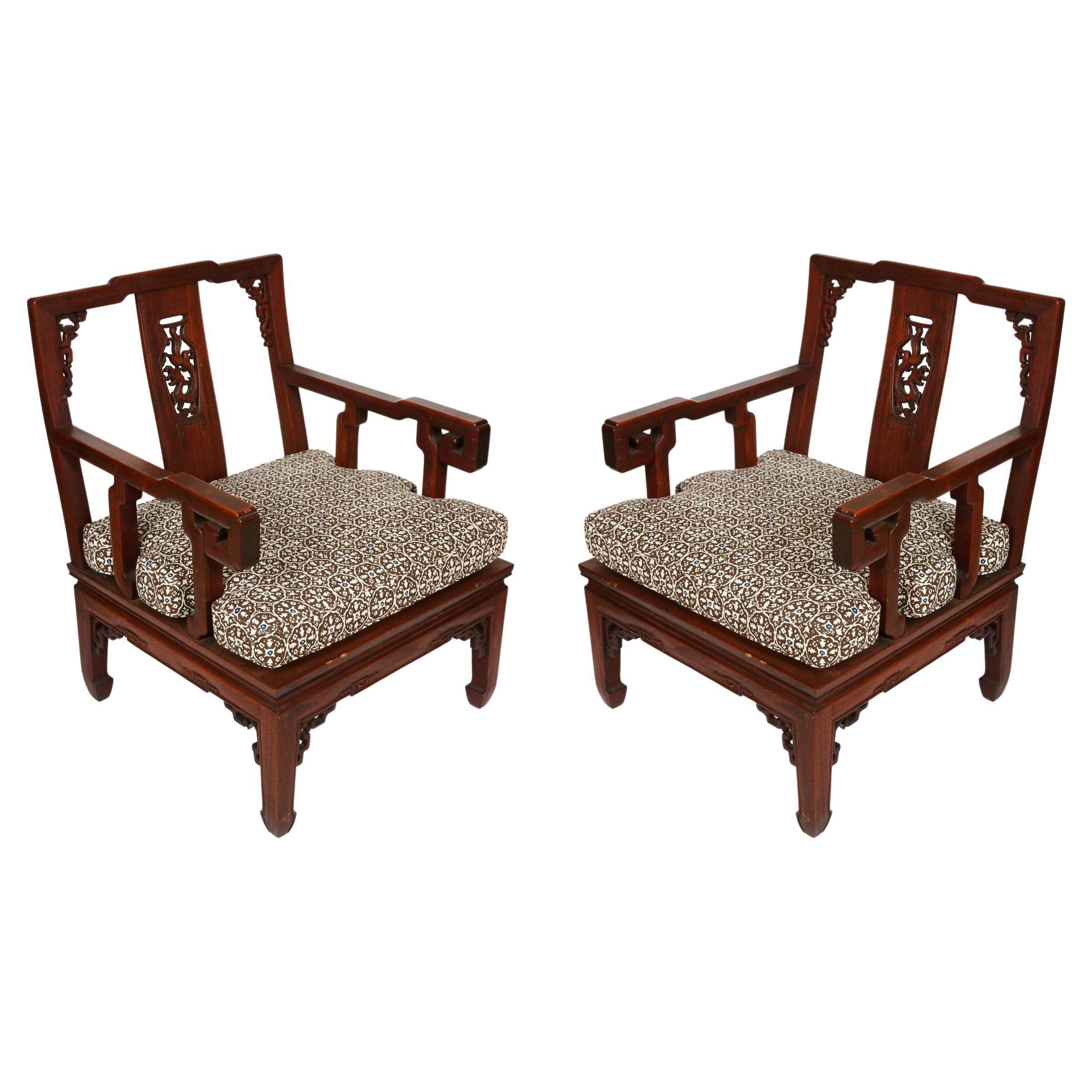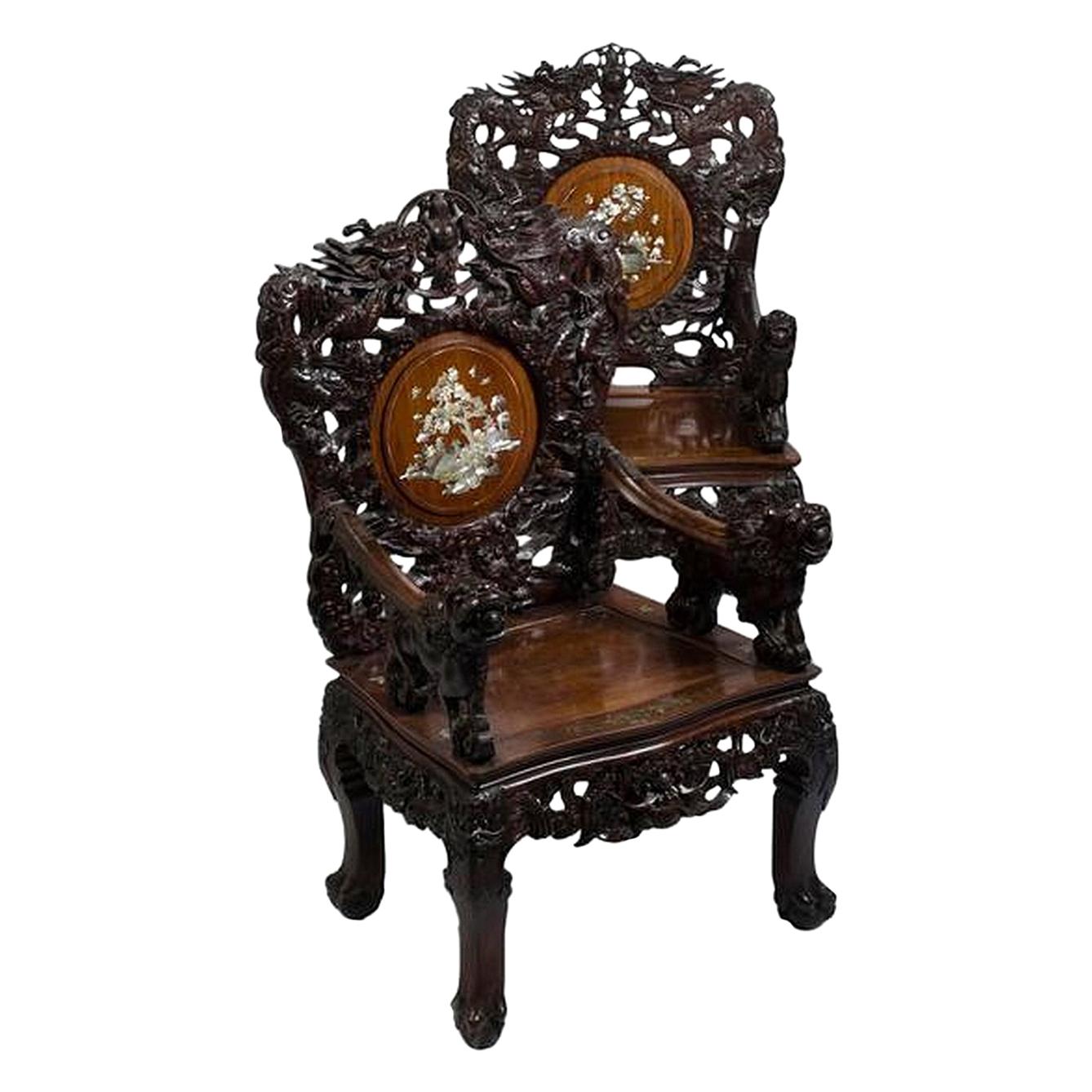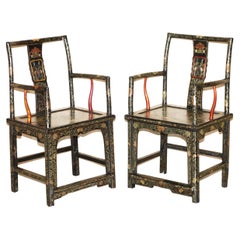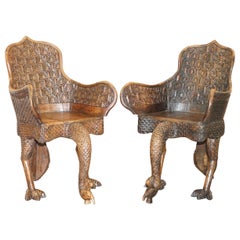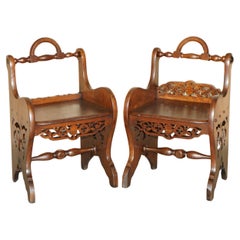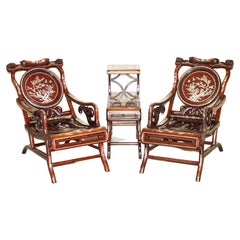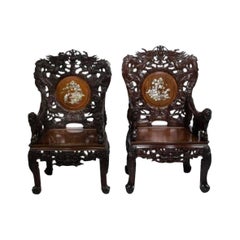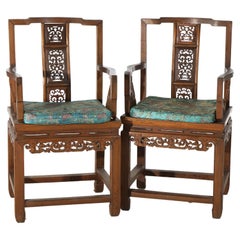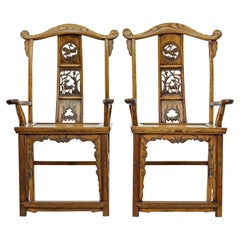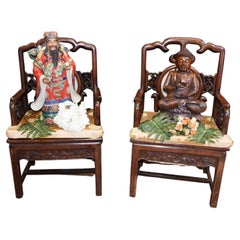Items Similar to Rare Pair of circa 1900 Tibetan Ceremonial Chairs Nyingma Buddha Carved in Backs
Want more images or videos?
Request additional images or videos from the seller
1 of 21
Rare Pair of circa 1900 Tibetan Ceremonial Chairs Nyingma Buddha Carved in Backs
$4,829.43per set
$6,899.18per set30% Off
£3,500per set
£5,000per set30% Off
€4,129.23per set
€5,898.90per set30% Off
CA$6,698.67per set
CA$9,569.53per set30% Off
A$7,303.01per set
A$10,432.88per set30% Off
CHF 3,858.77per set
CHF 5,512.53per set30% Off
MX$89,809.87per set
MX$128,299.82per set30% Off
NOK 47,980.71per set
NOK 68,543.87per set30% Off
SEK 45,167.48per set
SEK 64,524.97per set30% Off
DKK 30,825.44per set
DKK 44,036.34per set30% Off
About the Item
We are delighted to offer for sale this extremely rare pair of original circa 1900 Tibetan Ceremonial chairs with gold gilt decoration and large cast figures of the Buddhist god Nyingma
Where to begin! Wow, what a pair of large and important ceremonial chairs! They are very naively hand made but quite exquisite in their detail. The fronts depict peacocks and lots of floral detailing all of which is premium real gold gilt. The backs have the meditating figures of the Buddhist god Nyingma
In terms of the condition they are circa 120 years old and absolutely solid, as such they have patina marks here and there as you would expect. Really, they are just a stunning pair of spiritual chairs that will define a space in a powerful way
Dimensions:
Height 115cm
Width 58cm
Depth 66cm
Seat height 66cm frame only not including the cushion
Please note all measurements are taken at the widest point
The Nyingma tradition is the oldest of the four major schools of Tibetan Buddhism (the other three being the Kagyu, Sakya and Gelug). "Nyingma" literally means "ancient," and is often referred to as Ngangyur (IPA: [?a??u?], Tibetan: ????????????????, Wylie: snga 'gyur rnying ma, "school of the ancient translations" or "old school") because it is founded on the first translations of Buddhist scriptures from Sanskrit into Old Tibetan in the eighth century. The Tibetan alphabet and grammar was created for this endeavour.
The Nyingma particularly believes in hidden terma treasures and place an emphasis on Dzogchen. They also incorporate local religious practices and local deities and elements of shamanism, some of which it shares with Bon. The Nyingma tradition actually comprises several distinct lineages that all trace their origins to the Indian master Padmasambhava.
Traditionally, Nyingmapa practice was advanced orally among a loose network of lay practitioners. Monasteries with celibate monks and nuns, along with the practice of reincarnated spiritual leaders, are later adaptations. In modern times, the Nyingma lineage has been centered in Kham and has been associated with the Rimé movement.
Mythos
Traditional Nyingma texts see themselves as a lineage which was established by Samantabhadra (Güntu Sangpo), the “primordial buddha” (Adi Buddha) and who is also the embodiment of the Dharmakaya, the "truth body" of all buddhas. Nyingma also sees Vajradhara (an emanation of Samantabhadra) and other buddhas as teachers of their many doctrines. Samantabhadra's wisdom and compassion spontaneously radiates myriad teachings, all appropriate to the capacities of different beings and entrusts them to "knowledge holders" (vidyadharas), the chief of which is Dorjé Chörap, who gives them to Vajrasattva and the dakini Légi Wangmoché, who in turn disseminate them among human siddhas.[3] The first human teacher of the tradition was said to be Garab Dorje (b. 55 c.e.), who had visions of Vajrasattva. Padmasambhava is the most famous and revered figure of the early human teachers and there are many legends about him, making it difficult to separate history from myth.
Other early teachers include Vimalamitra, Jambel Shé Nyen, Sri Simha, and Jñanasutra. Most of these figures are associated with the Indian region of Oddiyana. Historical origins Buddhism existed in Tibet at least from the time of king Thothori Nyantsen (fl.173?-300? CE), especially in the eastern regions.[4] The reign of Songtsen Gampo (ca.617-649/50) saw an expansion of Tibetan power, the adoption of a writing system and promotion of Buddhism. Around 760, Trisong
Detsen invited Padmasambhava and the Nalanda abbot Santarak?ita to Tibet to introduce Buddhism to the "Land of Snows." Trisong Detsen ordered the translation of all Buddhist texts into Tibetan.
Padmasambhava, Santarak?ita, 108 translators, and 25 of Padmasambhava's nearest disciples worked for many years in a gigantic translation-project. The translations from this period formed the base for the large scriptural transmission of Dharma teachings into Tibet and are known as the "Old Translations". Padmasambhava supervised mainly the translation of tantras; Santarak?ita concentrated on the sutras.
Padmasambhava and Santarak?ita also founded the first Buddhist monastery in Tibet: Samye. However, this situation would not last: The explosive developments were interrupted in the mid-ninth century as the Empire began to disintegrate, leading to a century-long interim of civil war and decentralization about which we know relatively little.
The early Vajrayana that was transmitted from India to Tibet may be differentiated by the specific term "Mantrayana" (Wylie: sngags kyi theg pa). "Mantrayana" is the Sanskrit of what became rendered in Tibetan as "Secret Mantra" (Wylie: gsang sngags): this is the self-identifying term employed in the earliest literature.
Persecution
Part of the Dzogchen text The cuckoo of awareness, from Dunhuang. From this basis, Vajrayana was established in its entirety in Tibet. From the eighth until the eleventh century, this textual tradition (which was later identified as 'Nyingma') was the only form of Buddhism in Tibet. With the reign of King Langdarma (836–842), the brother of King Ralpachen, a time of political instability ensued which continued over the next 300 years, during which time Buddhism was persecuted and largely forced underground because the King saw it as a threat to the indigenous Bön tradition. Langdarma persecuted monks and nuns, and attempted to wipe out Buddhism. His efforts, however, were not successful.
A few monks escaped to Amdo in the northeast of Tibet, where they preserved the lineage of monastic ordination. The period of the 9-10th centuries also saw increasing popularity of a new class of texts which would later be classified as the Dzogchen "Mind series" (Semde). Some of these texts present themselves as translations of Indian works, though according to David Germano, most are original Tibetan compositions. These texts promote the view that true nature of the mind is empty and luminous and seem to reject traditional forms of practice.[8] An emphasis on the Dzogchen textual tradition is a central feature of the Nyingma school.
This item is available for collection from our Wimbledon warehouses
Condition:
Please view the very detailed pictures as they form part of the description around condition
Please note vintage period and original items such as leather seating will always have natural patina in the form of cracking creasing and wear, we recommend regular waxing to ensure no moisture is lost, also hand dyed leather is not recommended to sit in direct sunlight for prolonged periods of time as it will dry out and fade.
- Dimensions:Height: 45.28 in (115 cm)Width: 22.84 in (58 cm)Depth: 25.99 in (66 cm)Seat Height: 25.99 in (66 cm)
- Sold As:Set of 2
- Style:Edwardian (Of the Period)
- Materials and Techniques:
- Place of Origin:Tibet
- Period:1900-1909
- Date of Manufacture:1900
- Condition:Wear consistent with age and use. Minor fading.
- Seller Location:West Sussex, GB
- Reference Number:1stDibs: LU2823319570452
About the Seller
4.7
Platinum Seller
Premium sellers with a 4.7+ rating and 24-hour response times
Established in 2012
1stDibs seller since 2017
2,023 sales on 1stDibs
Typical response time: <1 hour
- ShippingRetrieving quote...Shipping from: West Sussex, United Kingdom
- Return Policy
Authenticity Guarantee
In the unlikely event there’s an issue with an item’s authenticity, contact us within 1 year for a full refund. DetailsMoney-Back Guarantee
If your item is not as described, is damaged in transit, or does not arrive, contact us within 7 days for a full refund. Details24-Hour Cancellation
You have a 24-hour grace period in which to reconsider your purchase, with no questions asked.Vetted Professional Sellers
Our world-class sellers must adhere to strict standards for service and quality, maintaining the integrity of our listings.Price-Match Guarantee
If you find that a seller listed the same item for a lower price elsewhere, we’ll match it.Trusted Global Delivery
Our best-in-class carrier network provides specialized shipping options worldwide, including custom delivery.More From This Seller
View AllPair of Chinese Antique Export Cir 1900 Lacquered & Painted Ming Style Armchairs
Located in West Sussex, Pulborough
We are delighted to offer for sale this stunning pair of highly decorative Chinese Export circa 1900-1920 hand painted and lacquered Ming style armchairs...
Category
Antique Early 1900s Chinese Chinese Export Furniture
Materials
Wood
$2,752 Sale Price / set
30% Off
Pair of Ornate Burmese Anglo Indian Hand Carved circa 1880 Peacock Armchairs
Located in West Sussex, Pulborough
We are delighted to offer for sale this lovely pair of extremely ornate hand carved Anglo Indian Burmese Peacock armchairs
What can I say, these have to be the most decorative cha...
Category
Antique 1880s Burmese Anglo-Indian Armchairs
Materials
Wood
$4,829 Sale Price / set
30% Off
PAIR OF ANTIQUE ViCTORIAN ENGLISH HAND CARVED HALL CHAIRS WITH ROTATING HANDLES
Located in West Sussex, Pulborough
Royal House Antiques
Royal House Antiques is delighted to offer for sale this stunning pair of original Victorian Arts & Crafts hall chairs with ornately carved frames and rotating ...
Category
Antique 1880s English Arts and Crafts Chairs
Materials
Oak
$2,152 Sale Price / set
20% Off
Pair of Antique Padauk & Mother of Pearl Reclined Plantation Armchairs & Table
Located in West Sussex, Pulborough
We are delighted to offer for sale this stunning pair of antique Chinese Padauk wood with ornate Mother of Pearl inlay reclined plantation style armchairs with matching side table
A very good looking and decorative pair of antique Chinese armchairs...
Category
Antique 19th Century Chinese Chinese Export Furniture
Materials
Padouk
$4,781 Sale Price / set
30% Off
Fine Pair of Fully Restored Antique Art Deco Armchairs Hand Carved Carved Panels
Located in West Sussex, Pulborough
We are delighted to offer for sale this stunning fully restored pair of antique hand dyed Cigar brown leather Art Deco club armchairs with hand carved panels.
An exceptionally goo...
Category
Antique Early 1900s English Art Deco Armchairs
Materials
Leather, Wood
$11,590 Sale Price / set
30% Off
Pair of Antique Chinese Chinoiserie Indian Decoration Campaign Folding Chairs
Located in West Sussex, Pulborough
We are delighted to offer for sale this super rare pair of Chinese Chinoiserie Military Campaign folding chairs which have Indian Elephant decoration.
A very good looking and decorative pair of antique Chinese armchairs...
Category
20th Century Chinese Chinoiserie Furniture
Materials
Wood
$3,035 Sale Price / set
20% Off
You May Also Like
Pair of Indochinese Armchairs, circa 1880-1900
Located in Paris, FR
Pair of Indochinese armchairs, circa 1880-1900, in finely carved and openwork ironwood, inlaid with a rich decoration of mother of pearl Marquetry.
The two armchairs are identical b...
Category
Antique Late 19th Century Chinese Armchairs
Materials
Mother-of-Pearl, Wood
$6,561 / set
Pair of Chinese Carved Hardwood Throne Armchairs with Silk Cushions Mid-20thC
Located in Big Flats, NY
A pair of Chinese throne arm chairs offer carved hardwood construction with pierced slat backs having foliate elements, silk upholstered cushions, and raised on straight and square ...
Category
Mid-20th Century Chinese Furniture
Materials
Silk, Upholstery, Hardwood
$1,320 Sale Price / set
20% Off
Pair of mid 19th century carved elm Chinese yoke back armchairs
Located in Debenham, Suffolk
Good quality pair of Chinese yoke back armchairs circa 1860.
These chairs would have been originally lacquered and have since been stripped back to the bare woodwork, sealed with a ...
Category
Antique Mid-19th Century Chinese Qing Armchairs
Materials
Hardwood
Pair of Antique Chinese Armchairs Hardwood Seat Chairs
Located in Potters Bar, GB
- Elegant pair of antique Chinese antiques in hardwood.
- Feature round marble inserts to the back rest.
- Classic Asian interiors look.
- ...
Category
Vintage 1910s Chairs
Materials
Hardwood
Pair of Asian Carved Hardwood Chairs
Located in Locust Valley, NY
A pair of Asian carved hardwood chairs in square shape with newly upholstered tailored cushions.
Category
Mid-20th Century Furniture
Materials
Hardwood
$3,840 / set
Pair of Indochinese Armchairs, circa 1880-1900
Located in Paris, FR
Pair of Indochinese armchairs, circa 1880-1900, in finely carved and openwork ironwood, inlaid with a rich decoration of mother-of-pearl marquetry.
The two armchairs are identical b...
Category
Late 20th Century Chinese Armchairs
Materials
Mother-of-Pearl, Wood
$6,561 / set
More Ways To Browse
Tibetan Buddhist
Shaman Antique
Tibet Chair
Large Buddhist
Ceremonial Chair
Antique Ceremonial Chairs
Buddha Chair
Antique Liberty Chair
Czech Leather Chairs
English Country Chair
European Fruitwood Chairs
Green Lacquer Chair
Mid Century Beechwood Chairs
Rust Chairs
Velvet Shell Chairs
18th Century Chair Fabric
1980s Plastic Chairs
70 S Chairs
